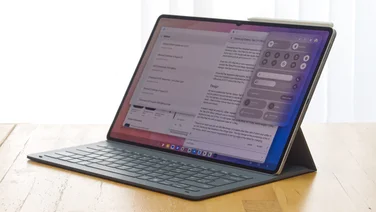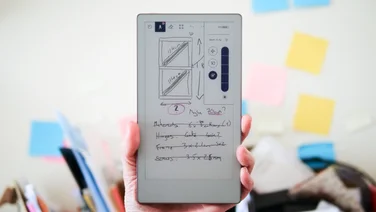To help us provide you with free impartial advice, we may earn a commission if you buy through links on our site. Learn more
- reMarkable 2 review: What you need to know
- reMarkable 2 review: Price and competition
- reMarkable 2 review: Design and key features
- reMarkable 2 review: The writing experience
- reMarkable 2 review: File-sharing and cloud subscription services
- reMarkable 2 review: Optional extras
- reMarkable 2 review: Verdict






- As close to paper as tech has come
- Deliberate simplicity aids concentration
- Syncs files neatly, even without a subscription
- Expensive, and you need to buy the Marker as well
- Useful features now paywalled behind monthly subscription
- Not waterproof
Are you still more comfortable with a pad and pen than with an iPad and Apple Pencil? Well, reMarkable 2 could be just for you.
A monochrome E Ink tablet that’s purely designed for note-taking, the reMarkable 2 has a panel built to mimic the feel of paper, but it doesn’t come with Netflix, Instagram or email. It connects to Wi-Fi, but that’s only so that your notes can be wirelessly shared for easy access elsewhere.
It’s a deliberately stripped-back offering, so does the reMarkable 2 do its one job well enough to justify the admittedly high price of entry? Let’s find out.
reMarkable 2 review: What you need to know
As someone whose claim to legible handwriting has withered on the vine after decades of underuse, I’m quite comfortable with the transition to digital note-keeping. But not everyone is: typing can be slow and noisy, and isn’t ideal if you need to draw a diagram on the fly.
On the other hand, paper can be an administrative nightmare: if half your notes are digital and the other half are scattered between notepads, then you’re going to lose something.
The reMarkable 2 is the answer to this, theoretically combining the best of both worlds with a digital surface that feels like paper for your note-taking and doodles. It connects to your computer locally or (optionally via a subscription) to Dropbox, Google Drive and reMarkable’s own cloud service for file storage, so that all your notes can be easily accessed across your hardware. It’s not waterproof, but hey: neither is paper.






As well as the ability to sync your notes, there’s another benefit here. The company estimates that the reMarkable 2’s 8GB of internal storage will hold 100,000 pages of written work, or around 500 paper notebooks, and that doesn’t include pages safely stored in the cloud. That obviously means fewer trees cut down for paper, and while you’d shy away from calling any consumer tech good for the planet, it does at least reduce your need to keep buying notepads if you’re a prestigious note-taker.
reMarkable 2 review: Price and competition
Given the low power requirements and the subsequent weak internals (a 1.2GHz dual-core ARM processor backed by 1GB of RAM), the price of the reMarkable 2 may cause you to do a quick double take.
You can buy it directly from reMarkable 2 for £339 delivered, and you’ll need to spend an extra £59/£109 for a Marker or Marker Plus stylus unless you only want to use the reMarkable 2 for reading. Oh, and the cloud-sharing Connect platform used to be free, but is now subscription-based, so you may be looking at an ongoing cost of £4 or £6 a month. You can get by without this, but more on that later.
It’s possible to save £40 by buying a refurbished model from the company, and that’s probably what we’d advise, since these are just as-new units returned during the company’s generous trial period. Said trial is definitely worth highlighting, by the way: just return the device to the company within 100 days via a free return service and you’ll get a full refund.






But even accounting for the generosity of the trial, there’s no sugarcoating it: reMarkable 2 is an expensive digital notepad, given its obvious limitations. There’s a school of thought that says it can afford to be, given there’s nothing really like it out there.
However, the upcoming Huawei MatePad Paper may change that, which seems to offer a very similar experience to the reMarkable 2. We haven’t tried one yet, but expect it to be around the £400 mark: not too dissimilar given it comes with a stylus in the box.
Then there’s the solution I’ve used previously: an Apple Pencil paired with a compatible iPad (in my case an iPad mini 5) and the fabulous Notability app, which I can’t rate highly enough. This isn’t a low-cost option, either: the cheapest way you could do this with current-gen products is the 2021 iPad (£319) and the first-generation Apple Pencil (£89) for a total of £408. With iPads, this is a sliding scale and you could spend well into four figures if you like the look of the 12.9in iPad Pro, for instance.
Other tablets have stylus support, of course: there’s the Samsung Galaxy Tab S8, which starts at £649 for the 11in model, and goes up to £999 for a massive 14.6in version, and comes with an S Pen in the box. That’s more than can be said for Microsoft’s excellent £999+ Surface Pro 8, where the Surface Slim Pen 2 is an extra £120.
The point is that none of these options is exactly cheap. And while they offer functionality that the reMarkable 2 can’t match, they don’t (MatePad Paper aside) offer the same USP: the paper-like feel. So, does reMarkable 2 actually do what the sales literature promises?
reMarkable 2 review: Design and key features
What’s surprising upon opening the reMarkable 2 box is just how thin and light the device is for what is, essentially, a 10.3in tablet. Without a case, it feels a bit like holding a clipboard, which is probably the feeling the designers were aiming for, and it weighs just 404g.
How it differs from a regular tablet in looks is its screen, which like Kindles and other ebook readers is a kind of off-grey colour even when switched off. When not in use, you get a simple text in the middle of the screen that says “reMarkable is sleeping”. Remembering to put it to sleep when you’re not using it will increase battery life, and you’re looking at a good few weeks of use if you do this between sessions.
There’s a silver bar along the left-hand side for holding it, and this also houses both the power button at the top and a USB-C port at the bottom for charging. That’s it: it’s a very minimalistic look.






Turn it on and the deliberate paucity of the offering is immediately clear: there’s just a list of your files, folders and notebooks, searchable via an onscreen keyboard, which pops up only when absolutely necessary. This navigation can be done by the finger, as can turning pages with a familiar swipe, but you won’t be able to actually write, making the Marker an essential purchase alongside the reMarkable 2.
You can filter by file type, or star items that you need to return to, but that’s about it. I would imagine this would be tough to navigate when you have thousands of files, but after a few weeks’ use, its simplicity is actually quite welcome.
reMarkable 2 review: The writing experience
Starting a new notepad, you’re immediately given a bunch of templates to suit your needs. You can have a blank sheet if you like, but you can also get something to imitate graph paper, checklists, lined jotters or whatever else you might need.

The Marker doesn’t need charging, so once you’ve set up a file, you’re off. At first, I would say that writing with the Marker doesn’t feel exactly like using a pen and paper – which isn’t surprising given paper’s softer, indentable qualities – but it’s certainly the closest approximation I’ve seen in the world of tech. More tellingly, after a few days of doodling, it felt more like what I remembered paper feeling like, and if it can successfully reset your expectations then that’s almost the same thing.
With regular notes, the screen has a response time of just 21ms, meaning there’s no lag in your writing appearing on the page as there are with other tablets. I tried writing as fast as I could, and it was slightly noticeable, but even then it wasn’t too distracting. Oddly, however, editing PDFs seems to have a slight delay on it – again, nothing too serious, but notable purely because of how well regular notes work on the tablet.
I tried going back to my iPad mini and Apple Pencil afterwards, and it really is a night-and-day difference. The Apple Pencil is a hugely impressive accessory, but it’s essentially working against the iPad’s glossy screen to feel natural, and the result is something that feels like a distant cousin of writing: without paper’s natural resistance, it slips around and you always feel like you’re tapping glass when making contact. Good results are definitely possible, but they won’t come as easily as with the reMarkable 2.
More importantly, I was interested to see the different kind of work I did on the reMarkable 2. Because the device is so barebones, you’re free of distraction and able to let your mind wander in a way that’s difficult on devices where a new tab or an addictive app is just a tap away. Yes, that’s also true of a paper notepad, but the weightiness of reMarkable and the need to turn it on somehow enhances your focus. Or it did for me, anyway: just writing notes one morning in bed, I came up with two freelance pitches which were duly tidied up and emailed off that morning. Both were accepted.
The flexibility of PDF importing also shouldn’t be understated. Not only can you sign contracts and documents more naturally, but I almost squealed with delight when I was able to import a PDF script I wrote in Fade In and start handwriting notes on top of it to myself, all without the need of a printer.
reMarkable 2 review: File-sharing and cloud subscription services
Backing up all these files is pleasantly simple, albeit not quite as simple as it used to be. If you bought a reMarkable before 12 October 2021, then you’re entitled to free access to its cloud-sharing platform, Connect. If not, that’s now a paid extra, costing £4 or £6 a month, depending on your needs.
Before I get to that, I should say that you can get by quite comfortably without either, as the company explains here. There’s software for PC, Mac and mobile that will automatically wirelessly sync your files and let you drop PDF and ePub files onto the device for easy reading and annotation. Rather neatly, there’s also a Chrome plugin that can send interesting articles straight to your reMarkable 2 to read later, too.






That may well be enough for you, but you undoubtedly get more by signing up to Connect. This comes in two flavours: Connect Lite simply offers unlimited cloud storage for £4 a month, while the full version gives you the ability to send pages via email, screen sharing, handwriting conversion and integration with Google Drive, Dropbox and OneDrive. It’s quite a compelling package, though £6 a month adds up to £72 per year, which is clearly a significant figure.
Nonetheless, you do get a decent amount of extra functionality for your money. Screen share is especially effective: just tap the button on the tablet and then open the app on your PC or Mac to accept the connection. The view is instantly duplicated, with no noticeable input lag as you doodle away on the big screen.
Handwriting to text isn’t quite as impressive, but is still a bit of a lifesaver. It took about 20 seconds to decode a full page of my handwritten notes, and there were plenty of mistakes where it couldn’t read what I’d written. Nonetheless, even if as many as one in 20 words are wrong, fixing these errors still beats transcribing the whole lot by hand, and it’s a great addition to have.






Oddly, I found the main selling point – Google Drive integration – the least successful of these bonus features. That’s partly because of the limitations: the only compatible file types you can access from your device are ePub and PDF files, although you’re also free to upload your jottings.
But I found that having tens of gigabytes of (mostly inaccessible) Drive content slowed reMarkable 2 to a crawl, making it frequently unresponsive and in need of a reboot. Connecting OneDrive – which I don’t actually use for anything else and is thus completely empty – fixed this problem, so there are ways around it. But even so, I think I’m actually happier just using the regular cloud storage or the app.
reMarkable 2 review: Optional extras
As part of the review bundle provided, reMarkable sent the accessories you can purchase alongside your new tablet: two Markers (required for note taking) and two cases, which are purely optional for added protection.
A Marker is technically optional, but basically essential. Yes, you can use reMarkable 2 without one, but only for reading books and PDF/ePub documents, which takes away the point of the device. If you just want to read, you’d be better off buying a basic £70 Kindle.
So, you’ll need one: the question is whether you want the ‘basic’ £59 grey Marker or the £109 black Marker Plus. Both are battery free, and attach magnetically to the side of reMarkable so they’re never lost. They each come with nine replacement tips, which reMarkable reckons should be good for between three and seven weeks’ use each – more are available at £14 for nine, or £34 for 25.
The difference between Markers comes down to the built-in eraser on the Plus model, which means you can flip it over and rub out notes you’ve made by mistake. You can erase with the cheaper Marker, but you have to select the eraser tip from the sidebar which is a bit less elegant (especially if you routinely hide the sidebar to give yourself a larger canvas to play with).
Then there’s the choice of cases for added protection. The £69 Folio case, which comes in a grey polymer weave, is just a pouch for putting your reMarkable 2 in. It also has a slot for the Marker, to avoid the risk of it falling off when the magnets are bumped around.
The more expensive Book Folio is a neat holder that the reMarkable 2 magnetically clips into, with a cover page that protects the screen when not in use. Disappointingly, it doesn’t sleep/wake the device when opened or closed, like Kindle cases do, but it’s definitely the nicer product, not least because reMarkable 2 is a bit slippery without the leather back. It starts at £119 for the same grey polymer weave, but can also be yours for £149 with a brown or black premium leather.
reMarkable 2 review: Verdict
reMarkable 2 surprisingly lives up to its branding: it really is remarkable. While not identical to writing on paper, it begins to feel natural within minutes, in a way that scribbling on an iPad with an Apple Pencil never quite does. The syncing – even without a Connect subscription – is speedy and trouble-free, too. This is all reMarkable 2 promised, and it’s what it delivers, without any unnecessary frills or extras, which can lead to surprising bouts of creativity.
But it’s certainly not cheap, especially if you’re getting one for personal use, without being able to expense it to your business. The cheapest usable package – a refurbished reMarkable 2 and basic Marker – comes to £358, which is pricier than the entry-level iPad, and not too far off the cost of one with an Apple Pencil to deliver the same functionality (albeit without the secret sauce that makes reMarkable just feel “right”).
The iPad, of course, also offers a web browser, millions of apps, a colour screen and other quality-of-life features, but that’s not the point. There’s a certain kind of person that the reMarkable 2 will appeal to, and I can’t see them being disappointed with it in their hands. With the 100-day money-back trial, if you think that person might be you, there’s no reason not to find out for yourself.










